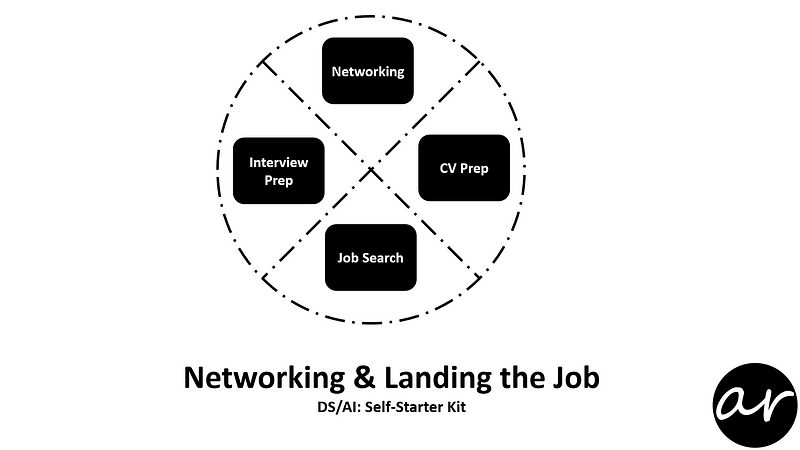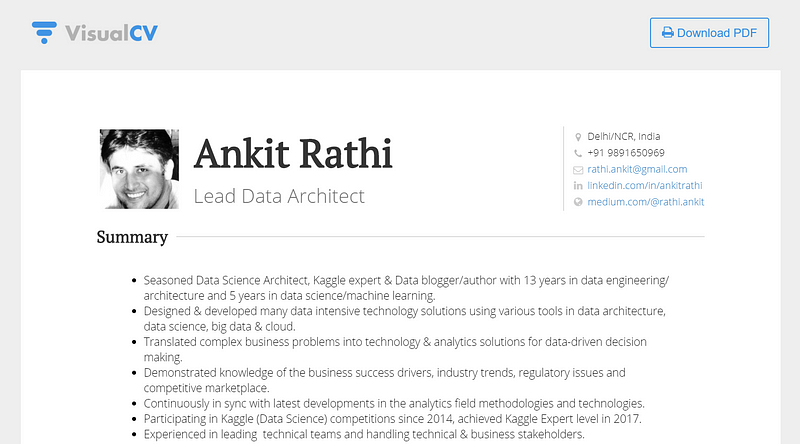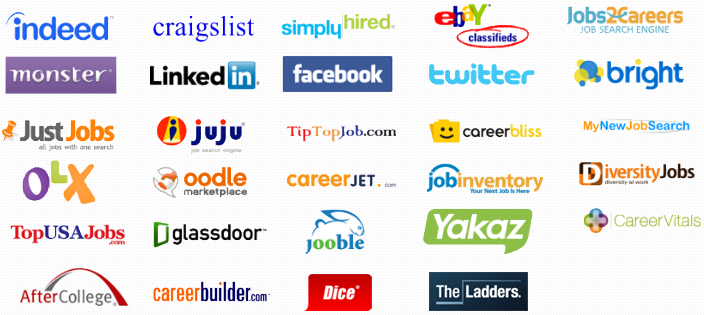| Previous | Table of Contents | Next |
So you have done all your homework, you traverse through the data intelligence landscape, you built required concepts and learnt relevant tools and you have started working on your portfolio as well.
Now its time to network with people, work on your CV/resume, start looking for a job and prepare for the interview.

Networking on LinkedIn

When it comes to networking on LinkedIn, there are two primary functions — just like in real-world networking: Building your network and nurturing relationships. I’ll cover both in this post.
Enrich Profile
Before using LinkedIn for networking, you need to update your profile and complete all sections to make it authentic, relevant, and compelling.
I would suggest you to avoid reaching out to new contacts and accepting connection requests until your profile was in tip-top shape. You need to assume that people will check out your profile when you are connecting. And with many connections, that’s your first impression.
Deny it all you want but first impression matters a lot.
Make sure your photo, headline, and summary all tell a compelling story of who you are and what you have to offer. Show that you’re worth connecting with! You can also request a recommendation from someone you’ve worked with so new connections have an impression of how you have helped others.
Interact
Being on LinkedIn for namesake is not enough, you need to interact with people to expand the network and get the visibility. Provide status updates on a regular basis. It keeps you visible to the people in your brand community.
Like and comment on LinkedIn posts that you think are valuable, and share the posts with your connections and other groups you belong to. Share content you find at other sites — like Fast Company or Forbes or Huffington Post — that you think would be valuable.
When sharing, remember to add content saying why you think it is valuable and expressing your point of view.
Publish
If you don’t have a blog, you can publish your articles on LinkedIn. As for the blog, you need to keep your article engaging, either it should entertain or educate or inspire. If your article does all of the three, nothing is better than that.
Write articles to solve problems. Divide your article into logical sections, like heading, introduction, main points and conclusion.
Keep images, embed content if required, to tell the story in your words.
More post likes should also get you LinkedIn shares, post views, and comments according to correlation data. You can encourage people to like your post with a call to action.
Reach Out
When you’re reaching out, remember to customize the request instead of using the default “I’d like to add you to my network.” You can even customize requests when using the LinkedIn mobile app.
Accept Requests
Know your criteria for accepting requests (and remember what you lose if you are a closed networker). LinkedIn alerts you when you have requested. Get in the habit of accepting them soon after receiving them.
Guide/Help Others
LinkedIn does the heavy lifting when it comes to staying on top of people in your network. They provide notifications when someone you know has a birthday, work anniversary, or new job.
You have the option of “liking” the notification or sending a message. I suggest choosing “send a message” and writing a personal note. Determine a time of day you will check-in and get in the habit of doing it daily so you don’t miss any of your connections’ important dates.
Now you have the keys for unlocking the power of networking on LinkedIn.
In all of these interactions, remember that successful personal branding is the result of being authentic and being consistent.
Preparing the CV

Keep it Short
You don’t have to list everything you’ve ever done. Try making a master resume which has all of your work history and then pulls what’s most relevant for each job.
Don’t put Objective
Objective serves no purpose in your resume since it doesn’t help you distinguish yourself while taking up spaces that can be better utilized to showcase more useful information about you such as projects, experiences, etc.
Picture
Based on in which region you are applying, you need to decide whether you can put your picture. While this is common in some countries in Europe and South America, it is not appropriate in the US and Asia.
Always Proofread
Having typos or grammar errors in your resume can be the quickest way to have your application eliminated. Use spell-check and have a friend to check it over.
Mention Accomplishments
Quantify your accomplishments where possible, use verbs to start the bullet points.
Add Cover Letter
If there is a place to submit a cover letter, do so. Just like your resume, you can have a master cover letter that you pull paragraphs from. Tailor at least the first and closing paragraph to the company and make sure you get their name correct.
Put Results & Links
Include the results and links of your projects. For instance, if you are doing a competition on Kaggle, it will be important to mention your ranking & you can put your solution on GitHub.
Mention Portfolio
Mention your LinkedIn, GitHub, Kaggle profiles links on your resume. It can reveal more useful information about yourself and it is also good to showcase the relevant work you have done.
Tailor for Job Description
It is crucial that you tailor your description of experience towards the job’s requirement because it can make your skills and experience seem more relevant and better fit for the position.
Highlight Coursework
You should list coursework that is relevant to the position you are applying to. It is a quick way to show hiring managers your background, which can have some influences in their decision on inviting you for interviews.
Don’t put Common Projects
Common projects and homework are highly guided problems that will help you to stand out. You should include projects that demonstrate your ability to solve real-world problems and your interests.
Don’t Rate your Skills
Numerical rating your skills are not meaningful since they are not standardized or calibrated.
Searching the Job

Have a Growth Mindset
Growth Mindset is believing that their most basic abilities can be developed through dedication and hard work — brains and talent are just the starting point. Don’t use “talent” to describe others as an excuse for your laziness. What you need is to learn the right way and practice many times until you are good at it.
Take Notes
Take note of all the interview questions you have been asked, especially those questions you failed to answer. You can fail again, but do not fail with the same question. Most of the time, you learn more about the topic when you reflect on the notes taken.
Browse widely
Jobs in DS/AI go by many names besides data scientist. These include product analyst, data analyst, research scientist, quantitative analyst, and machine learning engineer. Try searching for all of these terms to find positions and then use the description to evaluate the fit.
Do Self-reflection
Rather than applying to every type of data science job you find, think about your strengths and where you want to specialize. There are data scientists who have strong statistics skill and the ability to work with messy data and communicate results. While other data scientists have very strong coding skills, maybe have a background in software engineering, and focus on putting machine learning models into production.
Don’t demand perfection
Your first job in the field probably would not be your dream one. You may need to start out by moving to a position where you can leverage your other skills. That doesn’t mean you shouldn’t have certain requirements and preferences, but it does mean you’ll want to have some flexibility. The most important criteria for your first job may be that it has a supportive environment, with lots of other analysts, where you can learn a lot.
Don’t undersell yourself
Job descriptions are generally wish-lists with some flexibility. If you meet 80% of the requirements but are otherwise a good fit, you should still apply. With that said, be wary of job descriptions that describe a unicorn where they need every skill on earth. It usually means they don’t know what they’re looking for and they expect a data scientist to come and solve all their problems without any support.
Look on LinkedIn
Check if you know anyone at the company you’re interested in. If you don’t know anyone, see if there’s anyone in your alumni networks. You can also check for second connections and see if the person who bridges you can introduce you. Many jobs get hundreds if not thousands of applications for each position and having someone refer you or give you feedback on what the team is looking for is enormously helpful.
Check out Meetups/Conferences
Sometimes hiring managers will come to meetups or conferences to recruit. You may also meet someone in the company or sub-industry you’re interested in. If you ask if their company has an opening or if they can refer you, though, you’ll probably be directed to the company’s career page. This is why it’s important to build your network before you need it, means starting off with a strong ask is not a great way to build a mutually fulfilling relationship.
Cracking the interview

Prepare & Practice
Most of the questions (at least 60–70%) are based on your background and skills required for the job. Which means you can prepare a list of questions that can be asked to you and keep your responses comprehensive yet short.
You can also ask the recruiter about the number of rounds and what is expected at each stage so get as much information as you can and keep yourself prepared.
The Resume is a Fair Game
Whatever you have mentioned in your resume is a fair game. So keep everything on your fingertips. If you have mentioned a skill or a course, be prepared to be grilled about that.
Research about Company
You may have done some research when writing your cover letter, but once you get the interview, dig a little deeper. In addition to the tips in the thread below, find out about your interviewers’ professional accomplishments. I was very impressed when a candidate I was interviewing asked some technical questions about a presentation I had given.
Have Questions Ready
Each interviewer should leave time for questions at the end. If they don’t, that’s a bad sign. Interviewing is a two-way process: you’re evaluating them as much as they’re evaluating you. If you don’t know what to ask, you can prepare them based on what is important to you like the quality of life, culture, and management practices. You can ask each interviewer different questions to maximize how many you can get answered, but you could also try to ask multiple people the same questions to see if and how their answers differ.
Never Mention the Numbers
While it is a cultural thing, in some countries it is OK to mention your current salary while in other law prohibits the recruiter to even ask for it. Whatever is the case, never mention your expected salary.
If you name a number, you risk them giving you a lower offer than they would have otherwise. Their offer should not depend on your current salary or expectations; it should be your worth in the market and similar to the salary of your peers there.
Handle Rejection Gracefully
You will almost inevitably get rejected in some job interviews, maybe dozens of them. DS/AI is a competitive field and this is a very normal process that everyone goes through. If they reject you or you don’t hear back from them, you can express your disappointment politely and thank them for their consideration.
You can ask for feedback, but know that many hiring managers would not be able to give you any because they want to avoid the possibility of being sued. While it is okay to take a little time to wallow, just don’t lash out in public or to the hiring manager. It won’t help the situation, but it will hurt your professional reputation.
| Previous | Table of Contents | Next |